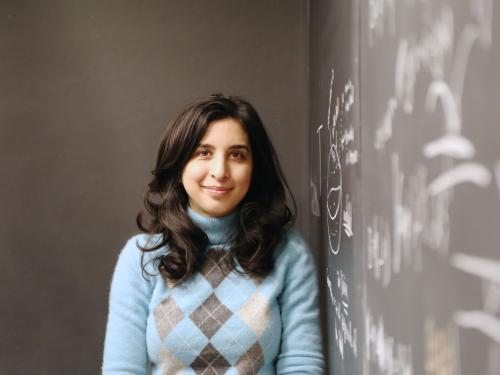
“For me, math has always been applicable,” said Sara Jamshidi, a graduate student studying mathematics.
She recalls when she was younger, how she and her father enjoyed creating math problems to solve together. “We would be watching TV and a claim would be made. We’d then sit down and do some calculations,” she said. These calculations could involve anything from the number of seats in a movie theater to whether or not a company’s donation cost more than the marketing to promote it.
Life as a mathematics graduate student has her studying far more abstract concepts now. Her adviser, Jason Morton, asks his graduate students to choose four different research projects for their doctoral thesis. Jamshidi’s four projects include studying the connections between quantum mechanics and evolution, Gröbner bases, transference in cognitive autonomy, and nonclassical probability theory, a far cry from the simple calculations she used to do with her father.
“We want to take things to an abstract level, which sounds like a bad thing to most people,” Jamshidi said. “If you strip away as much of the shallow information as possible, you get to the deeper stuff, then you can connect seemingly unrelated topics.”
She used this approach to her first research project involving evolution and quantum mechanics. By comparing the relationships between quantum particles to the relationships between different species, Jamshidi was able to use mathematical techniques for evolution to describe some quantum-entangled states.
“These virtual particles tell us how the physical particles are related to each other, how they’re entangled,” she said. “They are just like extinct species, which tell us how the species we see today are related to each other.”
Her second research project, involving Gröbner bases, might be her favorite of the four. “There are a lot of open problems in math that boil down to calculating something called a Gröbner basis,” she said.
Gröbner bases contain the building blocks to describe all the information of a mathematical problem. The challenge with any Gröbner basis is that finding it requires a lot of computing power, which makes it difficult to study. Morton received a grant from Amazon to use a set of their high-capacity computer cores and server space, which will help Morton and Jamshidi take an old Gröbner basis algorithm and attempt to calculate it in a more modern way.
“We’re writing a Gröbner basis algorithm that is in parallel instead of in series; we’re breaking up the steps and doing them simultaneously instead of in order,” she said. “Modern computers are powerful in that they have multiple cores, so we want to use them all at once and split up the work.”
Another research project involves work for the defense industry. For this, she has served as an intern for the Air Force Research Laboratory at Wright-Patterson Air Force Base and now interns with the Cognitive Autonomy Group at the Penn State Applied Research Laboratory.
Jamshidi works on improving information fusion and learning algorithms, called neural networks. She has developed a system of rules that allow machines to make decisions more like humans do.
“The data we feed into a neural network act like past experiences—the algorithm maps out patterns based on how you’ve programmed it to learn from those experiences and, with those patterns, it tries to make decisions in new situations,” she said.

The existing algorithms only work well when the situation doesn’t change much. Jamshidi uses imaging as an example. Social media images don’t change in composition much—consisting mostly of smiling faces—so it’s easier for a learning algorithm to identify important shapes associated to faces. But for defense purposes, reconnaissance images might change in composition quite a bit: different objects in different landscapes and differing cultural norms could make it difficult for a machine to identify elements in an image.
“These algorithms don’t always pick up the right features. They can mistake a toilet paper roll for a cell phone,” Jamshidi explained, which is why it’s important to develop algorithms that do a better job finding the important features.
“I’m trying to create a mathematical model that mimics what humans seem to do,” she said.
Outside of her research, Jamshidi has received quite a few accolades. She won a Dean’s Climate and Diversity Award in 2013 for her work organizing a diversity workshop for graduate students in the Department of Mathematics, and a Harold F. Martin Graduate Assistant Outstanding Teaching Award from The Graduate School for her teaching excellence. She was a student representative on the Dean’s Selection Committee, founded the Mathematics Teaching Discussion Group in her department, and regularly contributes to the Graduate Student subcommittee of the college’s Climate and Diversity Committee.
When she’s done with her doctoral degree, Jamshidi would like to find a job as a math professor, where she can still teach and conduct research, and continue her work with the defense industry.
In her free time, she enjoys knitting, brewing her own European-style beers, and reading. And, of course, spreading her enthusiasm for math wherever she goes.
“I’m of the opinion that everyone would love math if they knew more about it!” she said.
